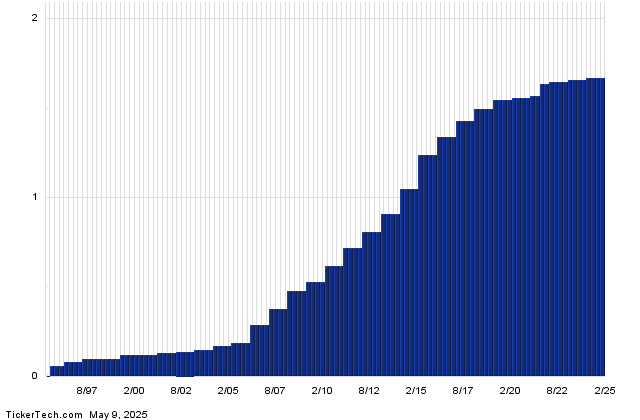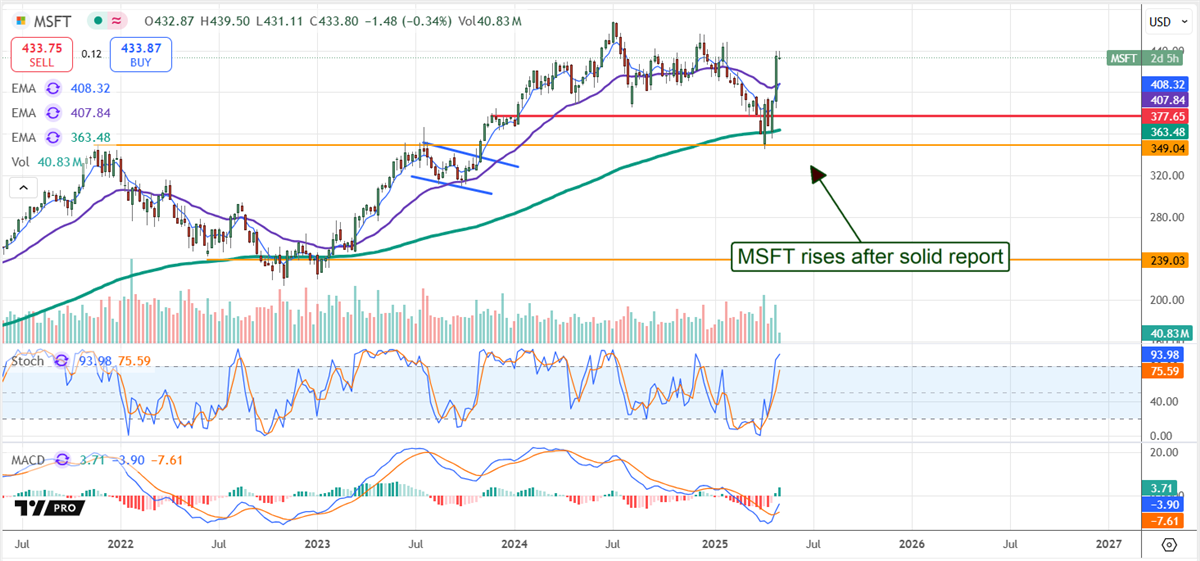Recession Fears Drive AI Stocks Down Despite Analysts’ Optimism
Artificial intelligence stocks are currently facing challenges due to tariffs imposed by the Trump administration, reigniting fears of a recession. This trend is particularly evident among the “Magnificent Seven,” as each stock in this category has declined year-to-date, with most experiencing drops of over 10%.
Despite these setbacks, select Wall Street analysts believe that shares of Nvidia (NASDAQ: NVDA) and Microsoft (NASDAQ: MSFT) are undervalued. Below are the insights shared by these analysts:
Start Your Mornings Smarter! Get Breakfast news delivered to your inbox every market day. Sign Up For Free »
- Vivek Arya from Bank of America forecasts a 12-month target price of $200 per share for Nvidia, indicating a potential upside of 69% from its current price of $118. This projection also suggests a market value of $4.8 trillion.
- Brent Thill at Jefferies anticipates Microsoft shares will reach $550 within the next year, reflecting a 42% upside from its current share price of $386, with a corresponding market value of $4.1 trillion.
With this in mind, here’s what investors should know about these AI stocks.
Nvidia: Potential for 69% Upside
Nvidia’s graphic processing units (GPUs) are integral to the most advanced artificial intelligence (AI) systems globally. According to Forrester Research, “Nvidia sets the pace for AI infrastructure worldwide. Without Nvidia’s GPUs, modern AI wouldn’t be possible.” The company’s strength lies not only in its GPUs but also in adjacent products like CPUs and networking solutions, effectively allowing it to construct entire AI data centers.
Currently, Nvidia’s stock is 21% below its peak value due to investor concerns regarding two main issues. Firstly, **DeepSeek** has reportedly trained a high-level reasoning model using fewer GPUs compared to U.S. companies such as OpenAI. Following this news, Nvidia’s stock price dipped, though CEO Jensen Huang contends that such market fears are unfounded. He argues that efficiency gains will enhance demand for AI hardware by making this technology more accessible to firms.
Secondly, strict export controls enforced by the U.S. government have limited Nvidia’s ability to sell its most advanced chips to clients in China and Russia, and have constrained sales in other markets as well. Consequently, the proportion of total revenue from China dropped from 21% in fiscal 2023 to 13% in fiscal 2025, and this figure might decrease further if new restrictions materialize.
Despite the associated risks, Nvidia anticipates favorable developments. The company has recently introduced its Blackwell GPUs, marking a significant advancement in data center acceleration. Jensen Huang stated that this product could become the “most successful product” in the company’s history. Moreover, Nvidia has developed comprehensive computing solutions for autonomous vehicles and robots, encompassing hardware, software development tools, and embedded systems.
The AI sector shows considerable growth potential, with Grand View Research projecting that investments in AI hardware, software, and services will expand at an annual rate of 36% through 2030. On the fourth-quarter earnings call, Huang noted, “No technology has ever had the opportunity to address a larger part of the world’s GDP than AI.”
Market experts predict Nvidia’s earnings will grow at an annual rate of 39% through fiscal 2027, which closes in January 2027. At this growth rate, the current price-to-earnings ratio of 39 may appear undervalued. Although uncertainty surrounding tariffs may temper expectations for a 69% return within the year, long-term investors may find it prudent to consider Nvidia.
Microsoft: Expected 42% Growth Ahead
As the foremost enterprise software provider and the second-largest public cloud service, Microsoft is well-positioned within two rapidly growing markets. Enterprise software sales are expected to rise by 12% annually until 2030, while cloud computing is projected to expand at 21% annually during the same period. This trajectory sets the stage for Microsoft to achieve solid earnings growth through the end of the decade.
In its endeavor to capture market share, Microsoft is integrating AI into its products across both segments; however, investor enthusiasm has lagged. The stock has declined by 17% from its record high in July, partly due to concerns that Microsoft may be overspending on AI development, especially regarding data center infrastructure and investments in OpenAI.
It is important to note that, as large language models become more commoditized, they may become interchangeable. Investing heavily in proprietary models, like those from OpenAI, may not yield competitive advantages unless they deliver distinct benefits uncontested by open-source alternatives from entities like **DeepSeek** and **Meta Platforms**.
On the brighter side, the efficiencies realized by DeepSeek bode well for Microsoft. With reduced costs for model training, demand for AI cloud services is likely to rise. A recent survey by **Morgan Stanley** revealed that Microsoft Azure is seen as the most likely public cloud service to gain market share in the next three years.
While the market reacted disappointingly to Microsoft’s financial outcomes for the second quarter of fiscal 2025 ending in December, CEO Satya Nadella shared positive developments. “Our AI business has surpassed an annual revenue run rate of $13 billion, reflecting a 175% increase year-over-year.”
Market consensus suggests Microsoft’s earnings will grow by 13% annually through fiscal 2026, which concludes in July 2026. The current valuation of 31 times earnings appears to hover between fair and expensive. However, Microsoft has historically outperformed consensus estimates by an average of 5% over the past six quarters. If this trend persists, the present valuation could be viewed more favorably in retrospect.
While it seems unlikely that Microsoft shares can achieve 42% growth over the next year, prospective investors should contemplate building a position now.
Is Nvidia Stock a Wise Investment Right Now?
Before investing in Nvidia, take a moment to consider the following:
The Motley Fool analyst team recently spotlighted what they think…
Top 10 Stocks to Invest In Now Without Nvidia
Currently, the 10 best stocks for investors have been identified, and notably, Nvidia is not part of this selection. The stocks selected have significant potential for substantial returns over the next several years.
Reflecting on the past, when Nvidia was recommended on April 15, 2005, an investment of $1,000 would now be worth an impressive $720,291*!
Stock Advisor offers investors a clear strategy for success. It includes advice on portfolio development, frequent analyst updates, and two new Stock picks every month. Since 2002, Stock Advisor has eclipsed the performance of the S&P 500 by more than four times.* Ensure you access the latest top 10 list by joining Stock Advisor.
Discover the 10 stocks »
*Stock Advisor returns as of March 18, 2025
Bank of America partners with Motley Fool Money for advertising. Randi Zuckerberg, a former Facebook executive and sister to Meta Platforms CEO Mark Zuckerberg, serves on The Motley Fool’s board. Trevor Jennewine holds positions in Nvidia. The Motley Fool endorses Bank of America, Jefferies Financial Group, Meta Platforms, Microsoft, and Nvidia. Additionally, it recommends the following options: long January 2026 $395 calls on Microsoft and short January 2026 $405 calls on Microsoft. Read the full disclosure policy from The Motley Fool.
The opinions expressed here belong to the author and do not necessarily represent those of Nasdaq, Inc.



